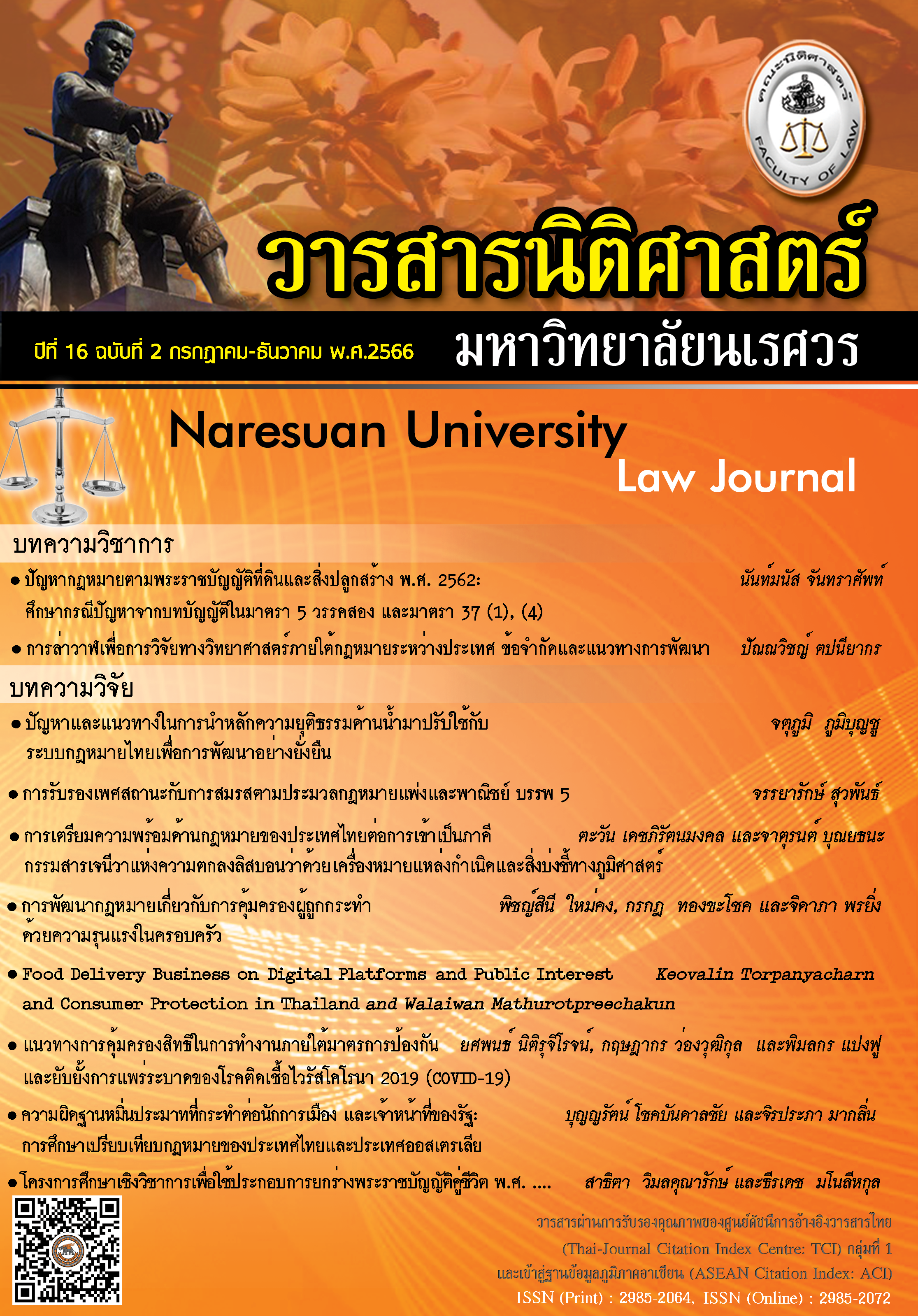ปัญหากฎหมายตามพระราชบัญญัติที่ดินและสิ่งปลูกสร้าง พ.ศ. 2562: ศึกษากรณีปัญหาจากบทบัญญัติในมาตรา 5 วรรคสอง และมาตรา 37 (1), (4)
Main Article Content
บทคัดย่อ
การจัดเก็บภาษีสำหรับที่ดินและสิ่งปลูกสร้างตามพระราชบัญญัติภาษีที่ดินและสิ่งปลูกสร้าง พ.ศ. 2562 ใช้บังคับตั้งแต่วันที่ 1 มกราคม พ.ศ. 2563 ภายหลังการบังคับใช้ดังกล่าวพบประเด็นปัญหาอย่างน้อย 2 ประการ ได้แก่ กรณีมาตรา 5 วรรคสี่ ที่ไม่ได้กำหนดให้ “สิ่งปลูกสร้าง” หมายความรวมถึงเครื่องจักร ส่วนควบ หรืออุปกรณ์ภายในสิ่งปลูกสร้างนั้นด้วย และกรณีมาตรา 37 (1) และ (4) ที่กำหนดให้มีการจัดเก็บภาษีที่ดินหรือสิ่งปลูกสร้างที่ถูกปล่อยให้รกร้างว่างเปล่าหรือไม่ได้ทำประโยชน์ตามควรแก่สภาพมีอัตราที่สูงกว่าการใช้ประโยชน์ในการประกอบเกษตรกรรม จากการศึกษาพบว่า การคำนวณฐานภาษีตามมาตรา 5 วรรคสี่ ไม่สะท้อนถึงมูลค่าของทรัพย์สินที่แท้จริงตามหลักความสามารถในการเสียภาษี ทำให้เกิดความไม่เป็นธรรมและทำให้เกิดความเหลื่อมล้ำในการจัดเก็บภาษี ส่วนปัญหาการจัดเก็บภาษีที่ดินหรือสิ่งปลูกสร้างตามมาตรา 37 (1) และ (4) พบว่า หลักเกณฑ์ที่ใช้พิจารณาในการประเมินการใช้ประโยชน์จากที่ดินเพื่อการเกษตรนั้นยังมีไม่ละเอียดเพียงพอ ทำให้มีการอาศัยประโยชน์ โดยการเปลี่ยนที่ดินที่รกร้างว่างเปล่าหรือไม่ได้ทำประโยชน์มาเป็นการทำเกษตร แต่ไม่ได้มีเจตนาทำการเกษตรอย่างแท้จริง จึงเสนอให้มีการแก้ไขเพิ่มเติมบทบัญญัติในมาตรา 5 วรรคสี่ ของพระราชบัญญัติภาษีที่ดินและสิ่งปลูกสร้าง พ.ศ. 2562 และเพิ่มเติมหลักเกณฑ์ในประกาศกระทรวงการคลังและกระทรวงมหาดไทยที่เกี่ยวข้อง
Article Details
เอกสารอ้างอิง
Criminal Court. “Documents for the Project to Disseminate Legal Knowledge and the Trial of Judicial Officers at the Court of Justice, from the Normal Way....To the New Style of Land Tax.” April 7, 2021. [In Thai]
Farmland Assessment Overview. “New Jersey Department of Agriculture.” Accessed October 10, 2022. https://www.state.nj.us/agriculture/divisions/anr/pdf/farmlandassessmentoverview.pdf/.
Royal Institute. Royal Institute Dictionary 2011. Bangkok: Royal Institute, 2011. [In Thai]
Rungnapha Santithamma. Taxation. Bangkok: TPN Press, 2018. [In Thai]
Siriya Dusitnanon. “Designing Thai Taxation System Based on Good Taxation Principles.” Law Journal Faculty of Law University of The Thai Chamber of Commerce 7, no. 1 (2015): 224-244. [In Thai]
Somkid Bangmo. Business Taxation. Bangkok: S. Asia Press (1989), 2014. [In Thai]
Somporn Fuengkritsada. “The Responsibility of the New Property Tax the from a Less Earner When the New Property Tax Act Legislation Promulgation: The Case Study Less Earner in the Community “Wat Tuek” in Samut Sakhon Province.” Master’s thesis, Chulalongkorn University, 2007. [In Thai]
Suphalak Pinitphuwadol. Explanation of Theory and Principles of Tax Law. Bangkok: Wisdom, 2004. [In Thai]
Suphalak Pinitphuwadol. Land and Building Tax Law. Bangkok: Winyuchon, 2022. [In Thai]
Suphalak Pinitphuwadol. Tax Law. Bangkok: Winyuchon, 2020. [In Thai]
Taweechai Meelarb. “Comparison of the Land and Building Tax Law In Thailand with the Real Property Tax Law in New York, USA: Case Study of the Tax Assessment and Administration Method.” Master’s thesis Independent Study, University of the Thai Chamber of Commerce, 2016. [In Thai]
Taxacctgcenter. “Features of Real Property Taxation in the Philippines.” Accessed October 10, 2022. https://taxacctgcenter.ph/features-of-real-property-taxation-in-the-philippines/.
Thatchalerm Suthipongpracha, and Attakorn Wongpridee. “Comparative Property: A Case Study from 7 Countries.” Journal of Public and Private Management 22, no. 2 (2015): 131-132. [In Thai]
Weerasak Kruethep. Deciphering the Local Taxation of Thailand. Bangkok: Faculty of Political Science Chulalongkorn University, 2013. [In Thai]


